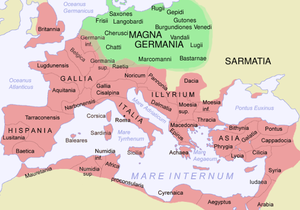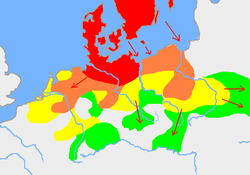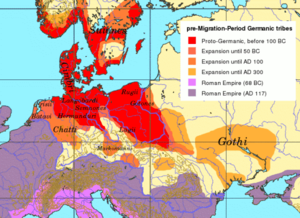Germania

Germania was the Latin exonym[1][2] for a geographical area of land on the east bank of the River Rhine (inner Germania), which included regions of Sarmatia as well as an area under Roman control on the west bank of the Rhine. The name came into use after Julius Caesar adopted it from a Gallic term for the peoples east of the Rhine that probably meant "neighbour".[3][4]
History

Germania was inhabited by different tribes, the vast majority Germanic but also including some Celtic, Baltic, Scythian, and proto-Slavic. The tribal and ethnic makeup changed over the centuries as a result of assimilation and, most importantly, migrations. The Germanic people spoke several different dialects.
The classical world knew little about the people who inhabited the north of Europe before the 2nd century BC. In the 5th century BC the Greeks were aware of a group they called Celts (Keltoi). Herodotus also mentioned the Scythians but no other barbarian tribes. At around 320 BC, Pytheas of Massalia sailed around Britain and along the northern coast of Europe, and what he found on his journeys was so unbelievable that later writers refused to believe him. He may have been the first Mediterranean to distinguish the Germanic people from the Celts. Contact between German tribes and the Roman Empire did take place, not only hostile. Recent excavations of the Waldgirmes Forum show signs that a civilian Roman town was established there, which has been interpreted to mean that Romans and Germanic tribesmen were living in peace, at least for a while.[7]
Caesar described the cultural differences between the Germanic tribesmen, the Romans, and the Gauls. He said that the Gauls, although warlike, could be civilised, but the Germanic tribesmen were far more savage and were a threat to Roman Gaul and so had to be conquered. His accounts of barbaric northern tribes could be described as an expression of the superiority of Rome, including Roman Gaul. Caesar's accounts portray the Roman fear of the Germanic tribes and the threat they posed. The perceived menace of the Germanic tribesmen proved accurate. The most complete account of Germania that has been preserved from Roman times is Tacitus' Germania.

Tacitus wrote in AD 98:
For the rest, they affirm Germania to be a recent word, lately bestowed. For those who first passed the Rhine and expulsed the Gauls, and are now named Tungrians, were then called Germani. And thus by degrees the name of a tribe prevailed, not that of the nation; so that by an appellation at first occasioned by fear and conquest, they afterwards chose to be distinguished, and assuming a name lately invented were universally called Germani.[8]
Regions
Germania was defined by Rome as having two regions: Lesser Germania, west and south of the Rhine, occupied by the Romans, and Greater Germania (Magna Germania) east of the Rhine. The occupied Germania was divided into two provinces: Germania Inferior (Lower Germania) (approximately corresponding to the southern part of the present-day Low Countries) and Germania Superior (Upper Germania) (approximately corresponding to present-day Switzerland and Alsace). The Romans under Augustus began to conquer and defeat the Germania Magna in 12 BC, having the Legati (generals) Germanicus and Tiberius leading the Legions. By AD 6, all of Germania up to the River Elbe was temporarily pacified by the Romans as well as being occupied by them. The Roman plan to complete the conquest and incorporate all of Magna Germania into the Roman Empire was frustrated when Rome was defeated by the German tribesmen in the Battle of Teutoburg Forest in AD 9. Augustus then effected Roman withdrawal from Magna Germania (completed by AD 16) and established the boundary of the Roman Empire as being the Rhine and the River Danube.
Modern use
"Germany" in English and similar names in other languages are derived from "Germania," though the country's own inhabitants call it "Deutschland". Several modern languages continue to use the name "Germania" including Hebrew (גרמניה), Bulgarian (Германия), Italian, Greek (Γερμανία), Romanian, Russian (Германия) and Armenian.
See also
- Roman Iron Age
- Germanic Europe
- Germanic peoples
- Limes Germanicus
- Germany
- Scandinavia
- The Netherlands
References
- ^ Stümpel, Gustav. Name und Nationalität der Germanen. Eine neue Untersuchung zu Poseidonios, Caesar und Tacitus (in German). Leipzig: Dieterich. p. 60.
- ^ Feist, Sigmund. Germanen und Kelten in der antiken Überlieferung (in German). Baden-Baden.
{{cite book}}: Check|first=value (help) - ^ Schulze, Hagen. Germany: A New History. Cambridge, MA: Harvard University Press. p. 4.
{{cite book}}: Check|first=value (help) - ^ "German", The Concise Oxford Dictionary of English Etymology. Ed. T. F. Hoad. Oxford: Oxford University Press, 1996. Oxford Reference Online. Oxford University Press. Accessed March 4, 2008.
- ^ Kinder, Hermann (1988), Penguin Atlas of World History, vol. I, London: Penguin, p. 108, ISBN 0-14-051054-0.
- ^ "Languages of the World: Germanic languages". The New Encyclopædia Britannica. Chicago, IL, United States: Encyclopædia Britannica, Inc. 1993. ISBN 0-85229-571-5.
- ^ Jones, Terry and Alan Ereira (2006), "Terry Jones' Barbarians", p.97. BBC Books, Ltd., London, ISBN 9780563539162.
- ^ Tacitus, Germania 2.
Further reading
- Malcolm Todd (1995). The Early Germans. Blackwell Publishing.
- Peter S. Wells (2001). Beyond Celts, Germans and Scythians: Archaeology and Identity in Iron Age Europe. Duckworth Publishers.
External links
- Germania (Roman provinces)
- 1849 Harper New York Map, Ancient Germanic Tribes and Towns
- Tacitus' Germania at the Latin Library (text in Latin)
- Tacitus' Germania (text in both Latin and English)
